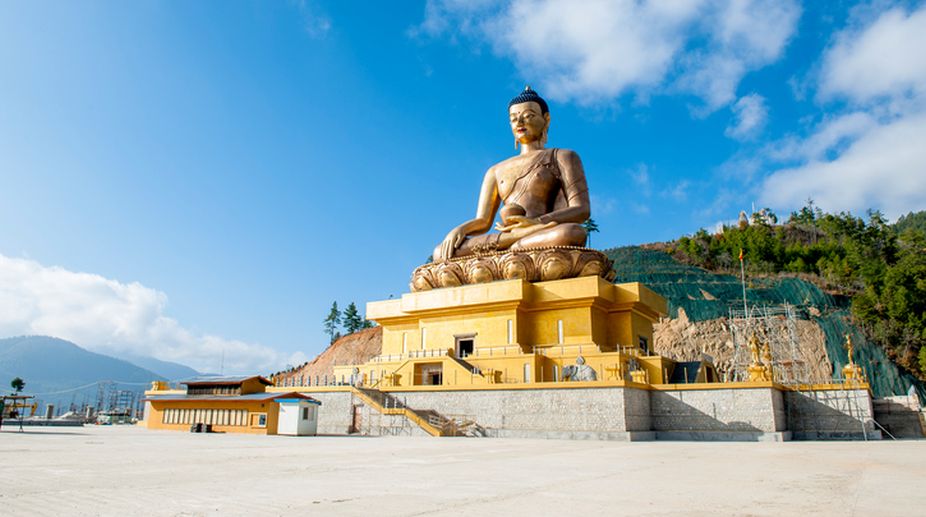In an effort to highlight places of interest in countries across the world, their varied culture, economy and history, The Statesman brings to you a Weekly Focus on countries with which India shares diplomatic ties and friendship. This week’s focus is on Bhutan. Know all about the country.
Capital: Thimphu ~ only city in the world with no traffic lights!, Currency: Indian rupee, Bhutanese Ngultrum (The Ngultrum is currently pegged to the Indian rupee at parity.), Language: French (official), Malagasy (official),
English, Religion: Lamaistic Buddhist 75.3 per cent, Indian ~ and Nepalese ~ influenced Hinduism 22.1, other 2.6 (2005 est.) Ethnic groups: Ngalop (also known as Bhote) 50 per cent, ethnic Nepalese 35 (includes Lhotsampas,
one of several Nepalese ethnic groups), indigenous or migrant tribes 15 per cent
Advertisement
CLIMATE
The climate varies with altitude, with the highest temperatures and rainfall occurring in the south which bears the brunt of the monsoon. Temperatures drop dramatically with increases in altitude though days are usually very pleasant with clear skies and sunshine. Nights are cold and require heavy woollen clothing, particularly in winter. Generally, October, November and April to midJune are the best times to visit – rainfall is at a minimum. The foothills are also very pleasant during the winter.
90 WEEKLY FLIGHTS
Druk Air flights and Bhutan Airlines fly directly between Delhi, Kolkata, Guwahati, Mumbai, Gaya, Bagdogra and Paro. Indians do not have to get visas.
WORKING RELATIONSHIP
About 60,000 Indian nationals live in Bhutan, employed mostly in the hydroelectric power and construction industry. In addition, 8,000-10,000 workers enter and exit Bhutan’s border towns daily.
Simple, rustic food
Bhutanese food is simple and rustic, based on the limited ingredients that can be grown in the challenging environment of the Himalayas. The core of Bhutanese cooking is rice ~ both white rice and red rice (eue chum), a nuttyflavoured variety grown for centuries in the Bhutanese hills. Chilli arrived by way of India and China, and it adds punch to many Bhutanese dishes. Chicken, eggs and dried yak meat are popular sources of protein, as is datshi, traditional unpasteurised cheese made from cows’ milk, which is melted into soups and stews. Tibetan staples such as momos are stuffed with pork, beef, vegetables or cheese, and many dishes feature apples, asparagus and wild mushrooms from the hills. Tibetan-style tea with salt and butter is sipped everywhere in Bhutan. Some specialities are Tshoem, PhakshaPaa,ShaKam, Hoentoe and Jasha Maru.
India is Bhutan’s largest trading partner
In 2015, bilateral trade reached `8,554 crore. Imports from India were `5,374 crore, accounting for 79 per cent of Bhutan’s total imports. Bhutan’s exports to India stood at `3,180 crore (including electricity) and constitute 90.3 per cent of its total exports.Total bilateral trade grew by about 7.3 per cent in 2015. Major exports from India to Bhutan are mineral products, machinery and mechanical appliances, electrical equipments, base metals, vehicles, vegetable products, plastics and articles.
The major items of import from Bhutan are electricity, ferrosilicon, Portland cement, dolomite, carbides of calcium carbides of silicon, cement clinkers,timber and wood products, potatoes, cardamom and fruit products. The most important economic cooperation between both countries is inhydropower projects. They provide a reliable source of inexpensive and clean electricity to India, generating export revenue for Bhutan and cement economic integration. So far, Government of India has constructed three Hydroelectric Projects (HEPs) in Bhutan totalling 1,416 MW, which export surplus power
MONASTERIES AND STATUES
Thimpu: Thimphu has retained its culture and old world charm as modern development is closely monitored and new buildings can be built only in Bhutanese style and up to a certain height. Tashichho Dzong, National Memorial Chorten and Motithang Takin are highlights.
Taktsang Monastery: Also known as Tiger’s Nest in Paro, this is one of the holiest places in Bhutan. Mounted on a high granite cliff, it was established for meditation. The monastery is perched on a rocky ledge with a sheer drop of nearly 800 metres and overlooks the Paro valley and the river. It is also an ideal place for a short trek.
Paro: Situated in a beautiful valley, surrounded by lush green rice fields, Paro is a historic town with many sacred sites. Along with Jakar and Punakha, Paro forms the ‘golden triangle’ of popular tourist destinations in Bhutan. In Paro, Rinpung Dzong is one of finest examples of a Bhutanese monastery. The Dzong hosts the Paro Tsechuie festival of masks.
Phuentsholing: The chief highlights are Amo Chuu, the Crocodile Breeding Centre, Chukha Hydrothermal Project, the gate at the border and Karbandi Monastery
Compiled by Kunal Jain (kunaljain@thestatesman.com)











